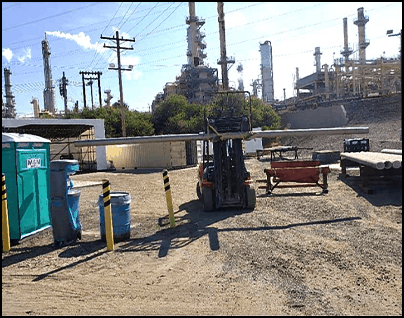-
What happened?
A driver was moving cement line piping from a pipe stand to a flatbed truck using a forklift.
The driver had to lift the pipes about 5ft (1.5m) to clear some pipe bollards.
After clearing the bollards, the worker tilted the forks forward instead of lowering them.
The two 4in x 20ft (10cm x 6m) cement line pipes rolled off the forks and hit the ground.
No one was injured. The cement pipes were damaged.

-
Why did it happen?
The load wasn’t secured as stated in policy guidelines.
- The requirements for lifting loads was unclear – guidelines stated that loads should be tied down and secured but did not specify whether a secured pallet load should be tied down.
The driver chose a shorter route where he was required to lift the load over obstacles, when a longer route with no obstacles was available.
The driver ignored the spotter’s suggestion to manually restrain the load.
Stop work procedure was not in applied when the job conditions changed.

-
What did they learn?
Block off any paths with obstacles so they cannot be used.
Ensure all forklifts are provided with restraining equipment.
Check that restraining equipment is in good condition before starting work. Include as a requirement for daily pre-use checklist.
Review policy guidelines to ensure clarity on what loads need to be secured (including examples). Include instructions on how to secure them.

-
Ask yourself or your crew
How can something like this happen here?
Do you have to follow any guidelines that aren’t clear? What can you do about this?
What checks do you carry out on loads before lifting?
What is the lifting route being used today? Is it clear, and is there a better route to use?

Add to homescreen
Content name
Select existing category:
Content name
New collection
Edit collection
What happened?
A driver was moving cement line piping from a pipe stand to a flatbed truck using a forklift.
The driver had to lift the pipes about 5ft (1.5m) to clear some pipe bollards.
After clearing the bollards, the worker tilted the forks forward instead of lowering them.
The two 4in x 20ft (10cm x 6m) cement line pipes rolled off the forks and hit the ground.
No one was injured. The cement pipes were damaged.

Why did it happen?
The load wasn’t secured as stated in policy guidelines.
- The requirements for lifting loads was unclear – guidelines stated that loads should be tied down and secured but did not specify whether a secured pallet load should be tied down.
The driver chose a shorter route where he was required to lift the load over obstacles, when a longer route with no obstacles was available.
The driver ignored the spotter’s suggestion to manually restrain the load.
Stop work procedure was not in applied when the job conditions changed.
What did they learn?
Block off any paths with obstacles so they cannot be used.
Ensure all forklifts are provided with restraining equipment.
Check that restraining equipment is in good condition before starting work. Include as a requirement for daily pre-use checklist.
Review policy guidelines to ensure clarity on what loads need to be secured (including examples). Include instructions on how to secure them.
Ask yourself or your crew
How can something like this happen here?
Do you have to follow any guidelines that aren’t clear? What can you do about this?
What checks do you carry out on loads before lifting?
What is the lifting route being used today? Is it clear, and is there a better route to use?
A worker was transporting cement line piping on site. They lifted it over some bollards, but then tipped the forks, allowing the piping to fall on the ground. No one was injured, but the pipes were damaged.










